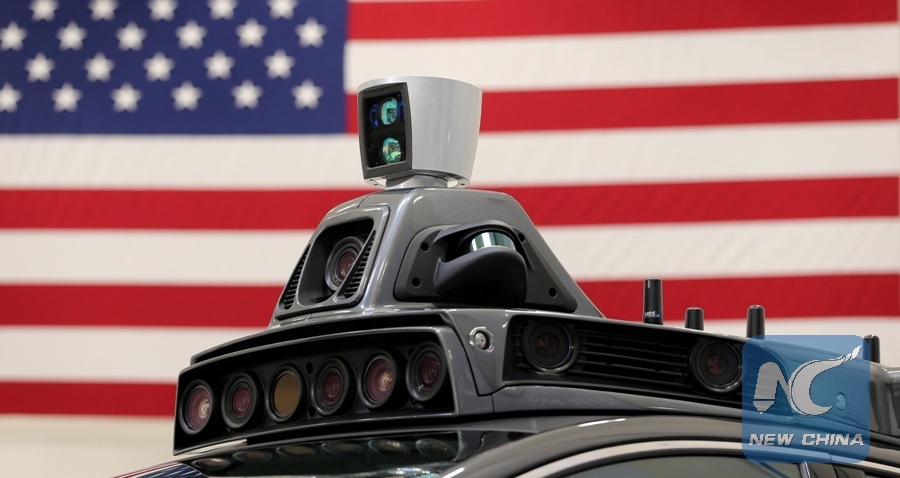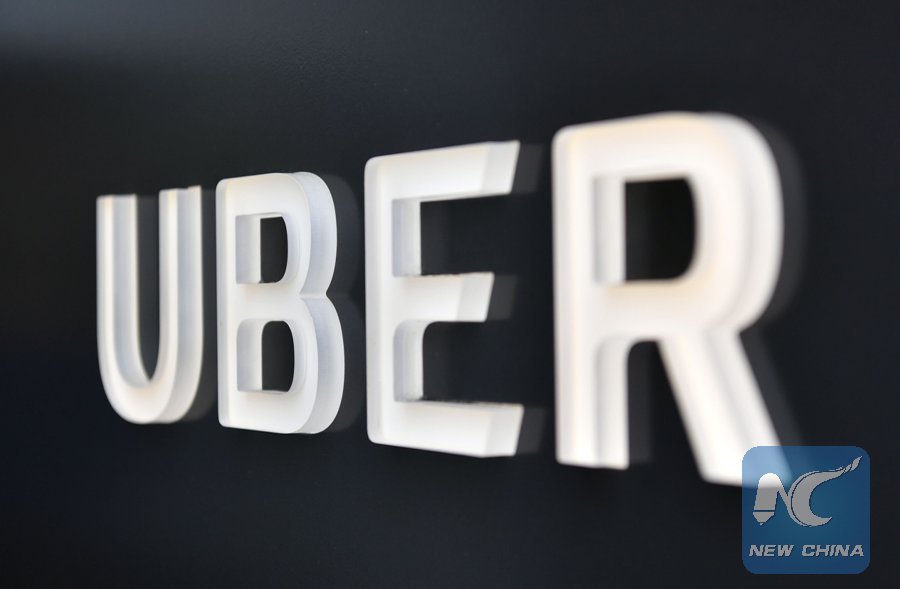
File Photo: A roof mounted camera and radar system is shown on Uber's Ford Fusion self driving car during a demonstration of self-driving automotive technology in Pittsburgh, Pennsylvania, U.S., September 13, 2016. (Xinhua/REUTERS)
by Peter Mertz, and Xinhua writers Guo Shuang, Zhou Zhou
DENVER, the United States, March 19 (Xinhua) -- Heated recently online has been the debate on whether self-driving cars are safe enough and who is to blame for the death on Monday of the woman hit by a self-driving Volvo SUV from the ride-hailing giant Uber traveling 40 miles (64 kilometers) per hour.
Social media users expressed sadness and regret for the death of 49-year-old Elaine Herzberg, who was pushing her bicycle across the street in Tempe City in the southwestern U.S. state of Arizona when she was hit by the Uber self-driving vehicle on Sunday.

File photo taken on Feb. 5, 2018 shows the Uber logo outside the Uber Corporate Headquarters building in San Francisco, California. (Xinhua/AFP)
Besides, reaction was strong and diverse across the United States especially in the west, where Arizona, California, and Utah had been vying to become the first American state to allow widespread use of self-driving cars by the end of 2018.
MATURER THAN HUMANS
The argument that cars driven by people cause thousands of deaths a year was one of many used by a majority of Americans who defended the fledgling self-driving car industry.
"The technology is already better than humans in many respects; it's never drunk, drugged, tired, had an argument, distracted, inattentive etc." noted Kate Carpenter of Britain's Chartered Institution of Highways and Transportation.
In 2016, 37,461 Americans were killed in 34,436 motor vehicle crashes, an average of 102 per day, U.S. National Highway Traffic Safety Administration data showed.
Tempe, Arizona police reported that the deceased was not walking within the "crosswalk" area -- which experts say was defined by the car's software as the place to stop -- when she was hit.
Timothy Lee who blogs on future transportation from Washington D.C., addressed the legal implications of the vehicle being the cause of death.
"The pedestrian is required to yield, and can be fined for J-walking, but a collision is ALWAYS the driver's fault," Lee wrote.
"This is done this way legally to make sure the mandatory car insurance the driver has covers the accident as the pedestrians have no mandatory insurance," he wrote.
MORE DETAILS NEEDED
Voices of concern on social media noted that forthcoming details of the tragedy will reveal every possible angle and explanation for what transpired.
"This will probably be the most well-documented and studied car-on-pedestrian crash in history," "Ignatius 345" wrote on MacRumors forum.

Uber CEO Dara Khosrowshahi tweets on the incident.
"It's important to remember that the car probably recorded this accident in extreme detail and we'll know exactly what happened soon enough," wrote Nela K on ArsTechnica, a tech news and analysis website.
From across the Atlantic Ocean in England, industry experts voiced dismay but hoped that self-driving car progress and adaptation will not be slowed.
"It is very unfortunate that a fatality has arisen," University of York professor John McDermid said, "but it serves to draw attention to the need for widely accepted approaches to assessing the safety of autonomous systems."
Like most, the York computer science professor defended the industry by saying safety questions can be answered in "a supportive way that enables the benefits to be realized, rather than blocking advancement of the technology."
By and large most interested parties asked "questions that must be answered in this case," as declared by engineering chance professor Duc Pham of the University of Birmingham.
Dr. Pham cited vehicle speed, brake functions, weather and road conditions, control systems and the existing straight-line path trajectory as variables that needed further analysis.
STILL EVOLVING
Still, most bloggers were looking for solutions and not to point blame for the terrible event -- the first time a person was killed by a self-driving car, the New York Times reported.
"Still evolving!" McDermid said, "One of the problems is that we do not have good frameworks for assessing safety of such systems, especially where they are learning.
"The car should take avoiding action. In principle the car should always be monitoring pedestrian behavior (even trying to predict it) so it can avoid the accident," he said.
"Lessons need to be learned so similar tragedies are avoided in future," said Matthew Channon, an expert on legal issues connected to driverless vehicles at the University of Exeter Law School.
"Those vehicles being tested are designed to act cautiously if anything is in their vicinity," Dr. Channon said.
"This is very sad," he added.
"Clearly, however, autonomous vehicles are still a work in progress and more research and development is needed to ensure they are safe for all road users in the future," Pham cautioned.

